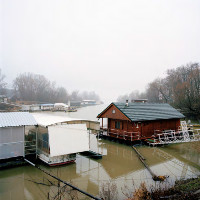| Gabriel Figueroa Flores/ MEX/ Baja& Alta 11.3.- 19.4.2015 |
|
The landscape means to me the vision of a metaphoric world of its own, in which the spectator sees himself reflected or confronted with the mystery of Creation, maybe, or with a reality whose form is different from him, but whose essence is the same that everything is made of.
It is a way of reflecting on the scale and dimension of existence, taking as reference two dimensions and the imagination to make them multidimensional.
The landscape turns out to be a necessity and an excuse for “being there”, in order to discover another portion of the immense mystery of the Created and, at the same time, to encounter the distant and distorted mirror of what you think you see and depict; it is also the perfect excuse for not seeing my body nor the body of anyone else who reminds me of my always disproportional ego; nevertheless, my point of view is the one who synthesizes my desire and therefore I come back to myself, recognizing behavioral patterns to stimuli, and I begin interpreting reality by my terms again.
I see this process as an ascending spiral which repeats itself, but not always at the same point, seeming recognizable but with multiple variables, mostly of space and time, which are probably the essential characteristics of photography. The passage of time can be observed through photography, by antagonism, the comparison of what was in the past with what it looks now. For many years, the copper canyons in Chihuahua looked “the same” in our dimension of time, now this has changed; a lot of things we saw ten years ago have changed irremediably due to different reasons like erosion or the birth of a volcano. Today more than ever, photography shows us the acceleration of changes throughout time.
By means of a photograph, I am able to make a synthesis of my environment's meaning, not only with photographs from my masters like my father, Ansel Adams, Hugo Brehme, Edward Weston, Álvarez Bravo, who created images that acquired stereotype quality, but also with my own attempts to be part of this field.
The landscape is like the skin of our reality; since it is alive, it changes constantly, and our vision changes with it.
If creating stereotypes is part of a vision that depends from multiple circumstances and ideologies, then making archetypes reappear in the landscape is an endeavor which promises a more permanent and complex environmental awareness, where our history imbricates with something more than a static vision; it is a dynamic in the relationship with the individual and collective surrounding at the same time.
What does this landscape mean to me?
As I said before, I wish I had a more complex vision of my environment. I want to take photographs of places considered “national monuments” or “landmarks” and make a visual reflection on their characteristics, express what they mean or meant to us. Something tells me that taking a second glance at those well-known or not so well-known landscapes is important in this moment.
|











